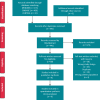Vernakalant for cardioversion of recent-onset atrial fibrillation: a systematic review and meta-analysis
- PMID: 31292622
- PMCID: PMC6680366
- DOI: 10.1093/europace/euz175
Vernakalant for cardioversion of recent-onset atrial fibrillation: a systematic review and meta-analysis
Abstract
Aims: To evaluate the efficacy and safety of vernakalant for the cardioversion of atrial fibrillation (AF).
Methods and results: We reviewed the literature for randomized trials that compared vernakalant to another drug or placebo in patients with AF of onset ≤7 days. We used a random-effects model to combine quantitative data and rated the quality of evidence using the GRADE (Grades of Recommendation, Assessment, Development and Evaluation). From 441 total citations in MEDLINE, EMBASE, and CENTRAL (December 2018), we identified nine trials evaluating 1358 participants. Six trials compared vernakalant to placebo, two trials compared vernakalant to ibutilide, and one trial compared vernakalant to amiodarone. We found significant methodological bias in four trials. For conversion within 90 min, vernakalant was superior to placebo [50% conversion, risk ratio (RR) 5.15; 95% confidence interval (CI); 2.24-11.84, I2 = 91%], whereas we found no significant difference in conversion when vernakalant was compared with an active drug (56% vs. 24% conversion, RR 2.40; 95% CI 0.76-7.58, I2 = 94). Sinus rhythm was maintained at 24 h in 85% (95% CI 80-88%) of patients who converted acutely with vernakalant. Overall, we judged the quality of evidence for efficacy to be low based on inconsistency and suspected publication bias. There was no significant difference in the risk of significant adverse events between vernakalant and comparator (RR 0.95; 95% CI 0.70-1.28, I2 = 0, moderate quality evidence). Vernakalant is safe and effective for rapid and durable restoration of sinus rhythm in patients with recent-onset AF.
Conclusion: Vernakalant should be a first line option for the pharmacological cardioversion of patients with haemodynamically stable recent-onset AF without severe structural heart disease.
Keywords: Amiodarone; Atrial fibrillation; Cardioversion; Ibutilide; Meta-analysis; Systematic review; Vernakalant.
Published on behalf of the European Society of Cardiology. All rights reserved. © The Author(s) 2019. For permissions, please email: journals.permissions@oup.com.
Figures




References
-
- Lloyd-Jones DM, Wang TJ, Leip EP, Larson MG, Levy D, Vasan RS. et al. Lifetime risk for development of atrial fibrillation: the Framingham Heart Study. Circulation 2004;110:1042–6. - PubMed
-
- Andrade JG, Verma A, Mitchell LB, Parkash R, Leblanc K, Atzema C. et al. 2018 focused update of the Canadian Cardiovascular Society guidelines for the management of atrial fibrillation. Can J Cardiol 2018;34:1371–92. - PubMed
-
- Kirchhof P, Benussi S, Kotecha D, Ahlsson A, Atar D, Casadei B. et al. 2016 ESC Guidelines for the management of atrial fibrillation developed in collaboration with EACTS. Europace 2016;18:1609–78. - PubMed
-
- Slavik RS, Tisdale JE, Borzak S.. Pharmacologic conversion of atrial fibrillation: a systematic review of available evidence. Prog Cardiovasc Dis 2001;44:121–52. - PubMed
Publication types
MeSH terms
Substances
LinkOut - more resources
Full Text Sources
Medical

